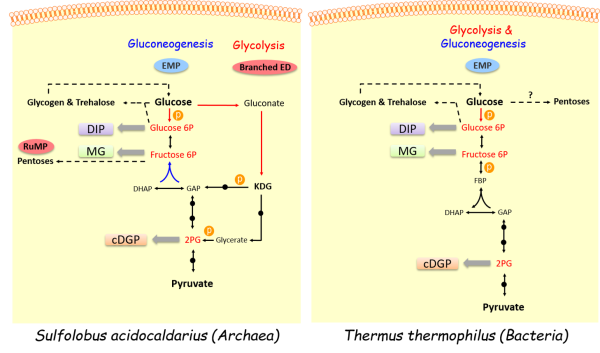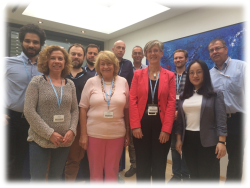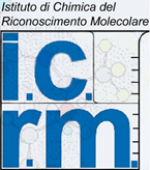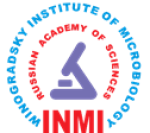Hot Solute
–HotSolute– Thermophilic bacterial and archaeal chassis for extremolyte production

Project plan
This ERA-CoBiotech project is developing thermophilic in vitro enzyme cascades as well as two new chassis, the thermophilic bacterium Thermus thermophilus (Tth, 65-75°C, pH 7.0) and the thermoacidophilic archaeon Sulfolobus acidocaldarius (Saci, 75-80°C, pH 2-4), as new thermophilic, bacterial and archaeal platforms for the in vivo production of novel high added-value products. These include ‘extremolytes’ that are small molecular compatible solutes found naturally in the cells of thermophilic species that accumulate in the cell in response to multiple environmental stresses and stabilize cellular components (including proteins, membranes). These Extermolytes possess great potential for application in the food, health care consumer care and cosmetics market. However, extremolytes cannot be produced in current mesophilic production hosts and therefore two thermophilic host Thermus thermophilus and Sulfolobus acidocaldarius of bacterial and archaeal origin, respectively, will be established as novel platform organisms.
The development of the newly designed ‘cell factories’ will be used for the production of three extremolytes, cyclic 2,3 di-phosphoglycerate (cDPG), di-myo-1,1’-inositol-phosphate (DIP) and mannosylglycerate (MG). These extremolyte biosynthetic pathways have been identified and many of the enzymes involved have been characterized. Within the project in addition to these enzymes, new candidates will be provided by (meta)genome searches and newly isolated strains from (hyper)thermophilic habitats.
Compatible Solutes and Extremolytes
Compatible solutes are ubiquitous and are found in all three domains of life. They accumulate to high concentrations in cells in response to diverse environmental stresses (e.g.heat, cold, osmotic stress, and desiccation) without interfering with cellular metabolism and allow their hosts to survive harsh environmental conditions by stabilizing and protecting biomolecular structures and the cellular conformation. Compatible solutes can be either taken up from the environment by the cell or are formed via de-novo synthesis. Many different compatible solutes are known that can be subdivided into different chemical categories such as (i) amino acids (e.g. α-glutamate, β-glutamate) and amino acid derivatives (e.g. glycine-betaine, ectoine, hydroxyectoine) as well as (ii) sugars (e.g. trehalose, MG), polyols (e.g. glycerol) and derivatives (51). Because of their protective effect on biological structures such as enzymes, DNA, membranes and whole cells, the compatible solutes have found commercial applications in different industrial fields such as food, health and consumer care and cosmetics.
Extremolytes are compatible solutes that are exclusively found in extremophiles and especially (hyper)thermophiles but not in mesophilic organisms. Such extremolytes include cyclic 2,3-di-phosphoglycerate (cDPG), di-myo-1,1’-inositol-phosphate (DIP) and mannosylglycerate (MG). However, their potential for industrial/biotechnological applications remains largely unexploited, mainly because efficient synthesis pathways to make their production economically viable are missing.
Thermus thermophilus and Sulfolobus acidocaldarius as new thermophilic, bacterial and archaeal platforms
The choice of the proposed thermophilic organisms is because many thermophiles are challenging to cultivate at scale without specialized fermentation conditions. However, both T. thermophilus and S. acidocaldarius are easy to grow on minimal and complex media up to high cell densities and under aerobic conditions, which allows large-scale fermentation processes to be easily established. Sugar transport and its degradation to pyruvate, oxidation to CO2 via the citric acid cycle (CAC) and oxidative respiration are well understood in these organisms (16-18).
Sulfolobus acidocaldarius
Sulfolobus acidocaldarius is a thermoacidophilic archaeon with optimal growth at 75-80°C and pH 2-4. The S. acidocaldarius grows on a range of carbon sources such as D-glucose, D-xylose, L-arabinose, starch, dextrin, saccharose, tryptone, NZ amine and single amino acids (19,20) (Fig. 1). D-glucose is degraded via a modified, branched Entner-Doudoroff (ED) pathway that is in contrast to the classical bacterial ED pathway and omits phosphorylation at the beginning of the pathway (24).
Thermus thermophiles (thermophile, Bacteria)
Thermus thermophilus is a thermophilic bacterium with optimal growth at 65-75°C and pH 7.0. T. thermophilus (strain HB8) grows on proteinacious substrates and carbohydrates and many exo-enzymes, (e.g. proteases, pullulanses, and glycosidases) are produced for polymer degradation (17,18,33) (Fig. 1). Glucose is degraded via the classical EMP pathway and is completely oxidized to CO2 via the CAC.

Fig. 1. Overview of the central carbohydrate metabolism in the thermoacidophilic archaeon Sulfolobus acidocaldarius and the thermophilic bacterium Thermus thermophilus. The Saci uses a branched Entner-Doudoroff (ED) pathway for glycolysis and the Embden-Meyerhof-Parnas (EMP) pathway for gluconeogenesis. The Tth uses a reversible EMP pathway for glycolysis and gluconeogenesis. The glycolytic intermediates serving as precursors for extremolyte production are shown in red. Important glycolytic reactions are shown by red and gluconeogentic reactions by blue arrows. The encircled P indicates phosphorylation sites.
Team

HotSolute kickoff Meeting in Hanau 2018 (Germany)
University of Duisburg, Essen, Germany
Christina Stracke
Bettina Siebers
Benjamin Meyer
University of Exeter, Exeter, UK
Simone De Rose,
Jennifer Littlechild
Istituto di Chimica del Riconoscimento Molecolare, Milan, Italy
Daniela Monti
Evonik Technology & Infrastructure GmbH, Essen, Germany
Felix Müller
Winogradsky Institute of Microbiology, Russian Academy of Science, Moscow, Russia
Kublanov Ilya
Sergey Gavrilov
Elizaveta Bonch-Osmolovskaya
Stellenbosch University, Stellenbosch, South Africa
Jacky Snoep
HotSolute is supported within the ERA CoBioTech action under H2020 (https://www.cobiotech.eu/home)
.
This project has received funding from the European Union’s Horizon 2020 research and innovation programme under grant agreement No [722361].






